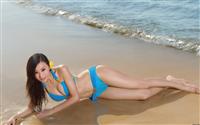Chapter two
Arthrology
Department of Anatomy
王 配 军
Classification
There are two major types of
articulations or joint.
? Continuous joints
?Fibrous joints, bones are
united by fibrous connective
tissue
?Cartilaginous joints, bones
are united by cartilage
?Synosteosis
? Discontinuous joints -
synovial joints
Synovial joints
Basic structures
? Articular surface,covered by
articular cartilage
? Articular capsule
?Fibrous membrane
?Synovial membrane
? Articular cavity,containing a
trace of synovial fluid;
subatmospheric pressure in it
Accessory structures
? Ligaments(lig.),extra-
and intracapsular
ligaments
? Articular disc and
articular labrum
? Synovial fold and
synovial bursa
Movements of joints
? Translation
? Flexion and extension
? Adduction and abduction
? Rotation
?Medial and lateral
rotation
?Pronation ans
supination
?Inversion and eversion
? Circumduction
Classification of synovial joints
? Uniaxial joints
? Biaxial joints
? Multiaxial joints
Articulations of Bones of Trunk
The vertebral
column consists
of 24 vertebrae,
the sacrum,and
the coccyx.
Joints of the vertebral bodies
Intervertebral discs
between bodies of
adjacent vertebrae,
composed of:
? Nucleus pulposus,an
inner soft,pulpy,
highly elastic structure
(gelatinous core )
? Annulus fibrosus
an outer fibrous ring
consisting of
fibrocartilage
Hemination of nucleus pulposus
髓核脱出
Anterior longitudinal ligament
? Maintains stability of the
intervertebral disc and prevents
hyperextension of the vertebral
column
Posterior longitudinal
ligament
? Prevents hyperflexion of the
vertebral column and posterior
protrusion of the discs
Joints of the vertebral arches
?Ligamenta flava ―
elastic ligament,
unite laminae of
adjacent vertebrae,
and complete the
posterior wall of
vertebral canal; tend
to prevent
hyperflexion of the
vertebral column
?Interspinal ligament
?Supraspinal ligament
?Ligamentum nuchae
?Intertansverse
ligament
?Zygapophysial joint
Atlantooccipital joint
? Between superior
articulating surfaces of
atlas and occipital
condyles
? Supported by
membrances and
ligaments that join
occipital bone and
atlas
? Action ― nodding of
head,lateral tilting of
head
Atlantoaxial joint
? Three synovial joints
between atlas and
axis
? Supported by
ligaments
? Action ― allow atlas
(and head) to pivot
on the axis and
vertebral column
Normal Curves of vertebral column
?Cervical curvature
?Thoracic curvature
?Lumbar curvature
?Sacral curvature
Movement of the vertebral
column
?flexion
?extension
?lateral flexion
?rotation
Spina bifida cystica 脊柱裂
Thoracic cage
Composition
Bones ― consists of
twelve thoracic
vertebrae,twelve
pairs of ribs and
costal cartilages,
and sternum
Joints
?Costovertebral joints
?Joints of costal head
?Costotransverse joints
?Sternocostal joints
?Sternocostal
synchondrosis of
first rib
?Sternocostal joints
?Interchondral
joints,between
costal cartilages 8,
9,and 10 to form
the costal arch
General features of thoracic cage
? Roughly cone-shape,
narrow above and broad
below,flattened from
before-backwards,
longer behind than in
front
? Inlet of thorax
? Outlet of thorax
? Infrasternal angle
? Intercostal spaces
?Function:
?protects the organs in the thoracic cavity
and upper abdominal cavity;
?plays a vital role in the process of breathing
Inspiration Expiration
Joints of skull
?Continuous joints,
sutures,
synchondrosis or
synosteosis
Temporomandibular joint
? Aticulating surfaces
? Capsule,thin and lax
in front and behind;
strengthened by the
lateral ligament
? Articular disc
? Movement
Arthrology
Department of Anatomy
王 配 军
Classification
There are two major types of
articulations or joint.
? Continuous joints
?Fibrous joints, bones are
united by fibrous connective
tissue
?Cartilaginous joints, bones
are united by cartilage
?Synosteosis
? Discontinuous joints -
synovial joints
Synovial joints
Basic structures
? Articular surface,covered by
articular cartilage
? Articular capsule
?Fibrous membrane
?Synovial membrane
? Articular cavity,containing a
trace of synovial fluid;
subatmospheric pressure in it
Accessory structures
? Ligaments(lig.),extra-
and intracapsular
ligaments
? Articular disc and
articular labrum
? Synovial fold and
synovial bursa
Movements of joints
? Translation
? Flexion and extension
? Adduction and abduction
? Rotation
?Medial and lateral
rotation
?Pronation ans
supination
?Inversion and eversion
? Circumduction
Classification of synovial joints
? Uniaxial joints
? Biaxial joints
? Multiaxial joints
Articulations of Bones of Trunk
The vertebral
column consists
of 24 vertebrae,
the sacrum,and
the coccyx.
Joints of the vertebral bodies
Intervertebral discs
between bodies of
adjacent vertebrae,
composed of:
? Nucleus pulposus,an
inner soft,pulpy,
highly elastic structure
(gelatinous core )
? Annulus fibrosus
an outer fibrous ring
consisting of
fibrocartilage
Hemination of nucleus pulposus
髓核脱出
Anterior longitudinal ligament
? Maintains stability of the
intervertebral disc and prevents
hyperextension of the vertebral
column
Posterior longitudinal
ligament
? Prevents hyperflexion of the
vertebral column and posterior
protrusion of the discs
Joints of the vertebral arches
?Ligamenta flava ―
elastic ligament,
unite laminae of
adjacent vertebrae,
and complete the
posterior wall of
vertebral canal; tend
to prevent
hyperflexion of the
vertebral column
?Interspinal ligament
?Supraspinal ligament
?Ligamentum nuchae
?Intertansverse
ligament
?Zygapophysial joint
Atlantooccipital joint
? Between superior
articulating surfaces of
atlas and occipital
condyles
? Supported by
membrances and
ligaments that join
occipital bone and
atlas
? Action ― nodding of
head,lateral tilting of
head
Atlantoaxial joint
? Three synovial joints
between atlas and
axis
? Supported by
ligaments
? Action ― allow atlas
(and head) to pivot
on the axis and
vertebral column
Normal Curves of vertebral column
?Cervical curvature
?Thoracic curvature
?Lumbar curvature
?Sacral curvature
Movement of the vertebral
column
?flexion
?extension
?lateral flexion
?rotation
Spina bifida cystica 脊柱裂
Thoracic cage
Composition
Bones ― consists of
twelve thoracic
vertebrae,twelve
pairs of ribs and
costal cartilages,
and sternum
Joints
?Costovertebral joints
?Joints of costal head
?Costotransverse joints
?Sternocostal joints
?Sternocostal
synchondrosis of
first rib
?Sternocostal joints
?Interchondral
joints,between
costal cartilages 8,
9,and 10 to form
the costal arch
General features of thoracic cage
? Roughly cone-shape,
narrow above and broad
below,flattened from
before-backwards,
longer behind than in
front
? Inlet of thorax
? Outlet of thorax
? Infrasternal angle
? Intercostal spaces
?Function:
?protects the organs in the thoracic cavity
and upper abdominal cavity;
?plays a vital role in the process of breathing
Inspiration Expiration
Joints of skull
?Continuous joints,
sutures,
synchondrosis or
synosteosis
Temporomandibular joint
? Aticulating surfaces
? Capsule,thin and lax
in front and behind;
strengthened by the
lateral ligament
? Articular disc
? Movement




